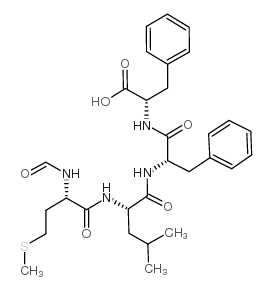The photoprotein pholasin as a luminescence substrate for detection of superoxide anion radicals and myeloperoxidase activity in stimulated neutrophils.
S Reichl, A Vocks, M Petković, J Schiller, J Arnhold
Index: Free Radic. Res. 35(6) , 723-33, (2001)
Full Text: HTML
Abstract
Pholasin, the photoprotein of the common piddock Pholas dactylus, emits an intense luminescence upon oxidation. The contribution of superoxide anion radicals and myeloperoxidase (MPO) to Pholasin luminescence in stimulated neutrophils was investigated. Data on Pholasin luminescence were compared with results of superoxide anion radical generation detected by the cytochrome c test as well as with the release of elastase and MPO. In N-formyl-methionyl-leucyl-phenylalanine (fMLP) stimulated neutrophils, most of the luminescence is caused by superoxide anion radicals, whereas MPO shows only a small effect as shown by coincubation with superoxide dismutase (SOD) as well as potassium cyanide (KCN), an inhibitor of MPO. However, both, O2- and MPO contribute to light emission in fMLP/cytochalasin B and phorbol myristoyl acetate (PMA) stimulated cells. Thus, the kinetics of O2- generation and MPO release can be very well detected by Pholasin luminescence in stimulated neutrophils. Degranulation of azurophilic granules was assessed using an ELISA test kit for released MPO or detection of elastase activity with MeO-Suc-Ala-Ala-Pro-Val-p-nitroanilide in the supernatant of stimulated cells. Both approaches revealed concurrently similar results concerning the amount and kinetics of enzyme release with data of Pholasin luminescence. Both, cytochrome c measurements and Pholasin luminescence indicate that fMLP/cytochalasin B and PMA stimulated neutrophils produce more O2- than fMLP stimulated cells. Thus, Pholasin luminescence can be used to detect, sensitively and specifically, O2- production and MPO release from stimulated neutrophils.
Related Compounds
| Structure | Name/CAS No. | Molecular Formula | Articles |
|---|---|---|---|
 |
For-Met-Leu-Phe-Phe-OH
CAS:80180-63-8 |
C30H40N4O6S |
|
Formyl peptide chemoattractants: a model of the receptor on ...
1982-01-19 [Biochemistry 21 , 257, (1982)] |
|
Effect of human C-reactive protein on chemokine and chemotac...
1998-09-01 [J. Immunol. 161(5) , 2533-40, (1998)] |
|
Control of fluid shear response in circulating leukocytes by...
2002-03-01 [Ann. Biomed. Eng. 30(3) , 333-43, (2002)] |
|
Characteristics of binding of a potent chemotactic formyl te...
1988-05-01 [J. Leukoc. Biol. 43(5) , 420-8, (1988)] |
|
Interaction of Bordetella pertussis virulence components wit...
1988-08-01 [J. Gen. Microbiol. 134(8) , 2201-11, (1988)] |